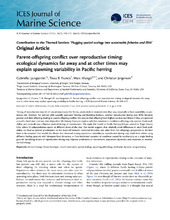Parent-offspring conflict over reproductive timing: ecological dynamics far away and at other times may explain spawning variability in Pacific herring
Peer reviewed, Journal article
Published version

Åpne
Permanent lenke
http://hdl.handle.net/1956/21795Utgivelsesdato
2019Metadata
Vis full innførselSamlinger
Originalversjon
https://doi.org/10.1093/icesjms/fsy106Sammendrag
Timing of reproduction may be of crucial importance for fitness, particularly in environments that vary seasonally in food availability or predation risk. However, for animals with spatially separated feeding and breeding habitats, optimal reproductive timing may differ between parents and their offspring, leading to parent-offspring conflict. We assume that offspring have highest survival and fitness if they are spawned around a fixed date, and use state-dependent life-history theory to explore whether variation in conditions affecting only parents (food availability and survival) may influence optimal timing of reproduction. We apply the model to Pacific herring (Clupea palasii) in Puget Sound, USA, where 20 subpopulations spawn at different times of the year. Our model suggests that relatively small differences in adult food availability can lead to altered prioritization in the trade-off between maternal fecundity and what from the offspring’s perspective is the best time to be spawned. Our model also shows that observed among-population variability in reproductive timing may result from adults using different feeding grounds with divergent food dynamics, or from individual variation in condition caused by stochasticity at a single feeding ground. Identifying drivers of reproductive timing may improve predictions of recruitment, population dynamics, and responses to environmental change.
